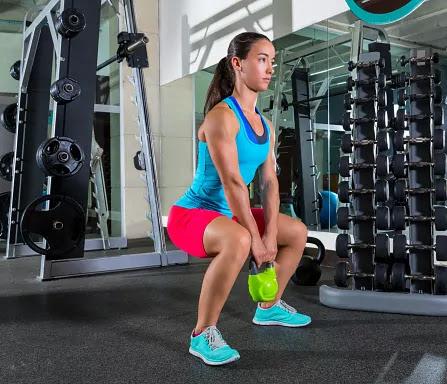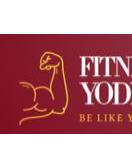The Goblet Squat: Target your Quads, Glutes, and Hamstrings
Dig in to focus on your quads, glutes, and hamstrings with the cup squat

You don't should be the glad holder of a cup to pull off this viable lower-body move, however, it requires a portable weight (or a hand weight).
The move, concocted by American quality and molding mentor Dan John to assist individuals with acing the right development example of the barbell back squat, is supposed on the grounds that you hold an iron weight by the handle with two hands at jawline stature, much like the manner in which you would hold an enormous flagon not long before taking a major swallow.
It may sound somewhat diverting, however, it's a genuine exercise in the event that you need to ace your structure in front of doing heavier compound lifts, for example, back squats, front squats, and deadlifts, limiting the danger of an excruciating lower-back injury that could save you uninvolved for quite a long time. Since the heap is before you, the challis squat makes a characteristic balance, making it simpler to keep your middle upstanding. It will likewise assist with forestalling your heels ascending off the floor and tipping your advances.
The challis squat is additionally a profoundly viable exercise for consuming fat since you can do a high number of reps in a single set (in a perfect world towards the finish of a loads exercise) to get your pulse high and increment vitality and oxygen utilization so your body is compelled to consume more calories during its recuperation cycle.
The challis squat will likewise improve adaptability around the hips, just as your lower-body quality and equalization. To put it plainly, there's a lot to like about the flagon squat. Peruse on for tips and counsel on the best way to join this incredible leg practice into your preparation stockpile.
The most effective method to Do A Goblet Squat
The arrangement for the cup squat is critical, in that it makes it difficult for your structure to turn out badly during the activity itself. Remain with your feet situated only a bit more extensive than your shoulders. Hold a load against your chest, with your elbows took care of as though you're holding a challis – like we as a whole do every now and then.
In case you're utilizing a free weight, hold it vertically. In the event that it's a portable weight, snatch the "horns" – the side of its handle. In the event that you have not one or the other, get something you can hold against your chest.
As you squat, keep your elbows inside the line of your knees, and the impact points of your feet level on the ground. Go as low as possible in this position, at that point return up, pushing through your heels. Keep your developments estimated and your abs strained as you move.
Focus on ten to 12 reps in three to five sets, three to five times each week. Either include flagon squats into your typical exercise schedule or work through your sets as an independent exercise. When alright with the procedure, you can develop the test with heavier loads, or accomplish more reps in case you're going for continuance over bulk.
Regular Form Mistakes
While attempting most moves just because, it very well may be anything but difficult to fall into some straightforward structure mistakes that can before long become enormous issues, both regarding expanded injury hazard and not burdening the objective muscles as far as possible. The challis squat is no special case. Here are the absolute most normal missteps and how to keep away from them.
Falling forward
The challis squat, similar to every single squat variety, expects you to keep your chest up consistently to keep your focal point of gravity over your feet. Start by standing tall with your chest up and center around keeping up this body position.
Falling in reverse
The way to maintaining a strategic distance from this is to keep your lats – the enormous muscles down the backsides of your middle – tight all through every rep to keep your body adjusted and stable. Do this by imagining somebody is remaining behind you attempting to stimulate your armpits, so you attract your elbows towards your sides.
Wobbling
Ensure you start every rep with your abs and lower back close and strained. This will keep your middle more steady and help with making a smoother and controlled rep. Zero in on pressing and straining your glutes at the head of every rep, as well.
Goblet Squat Variations
Goblet squat with overhead press
On the off chance that you possibly possess energy for one exercise when you hit the rec center, this combo-move likely could be your smartest choice for all-around outcomes. In addition to the fact that you get the lower-body quality advantages of the challis squat, however, you additionally work your chest area by squeezing the weight overhead. This enrolls your shoulder and back muscles just as expanding the test to your center. On the head of that, on the off chance that you perform long arrangements of this activity or use it as a major aspect of a HIIT circuit, you'll improve your cardiovascular wellness too.
You can play out the move by squeezing the iron weight overhead with two hands as you return up from your squat, or utilize one hand to press the weight up and change to the next once you've finished a large portion of the reps in your set. This last variety will work the muscles in your chest area singularly, and you'll have the option to spot on the off chance that one side of your body is more grounded than the other. Lifting the portable weight each arm in turn additionally builds the work your center does to oppose the revolution and keep your middle upstanding.
Slow, respite and heartbeat
The most well-known approach to make flagon squats more earnestly is to expand the heaviness of the iron weight you hold, yet in the event that you just have one weight accessible there are a few others approaches to up the force.
Start by hindering the speed of the plummet – tally to three or even five as you lower, ensuring you don't arrive at the base of your squat before you complete the process of checking. At that point drive back up rapidly.
Stopping during the development is likewise an incredible method to expand the test. You can do this at the base of the development, holding the squat for a couple of moments before pushing back up, or lower in stages, delaying a few times in transit down like a lift halting at various floors.
Also, if you truly need to feel the consume in your legs during your squat meeting, include beats at the base of the development. Push up somewhat and afterward lower again five to multiple times, trying to keep your back straight while beating. At that point drive back up to the beginning position,.
Cup squat with obstruction band
Wrap an obstruction band around your feet or shins, and move your legs separated until the band is tight before you squat. All through the development, you'll need to neutralize the band to stop your legs from falling in, and this fortifies the external glutes and thighs. This thus will help guarantee your legs don't collapse during all your future squats, in any event, when there's no band included.
Twofold portable weight front squat
This is a genuine overhaul in trouble on the challis squat since you're multiplying the heap, and when working with hefty portable weights it's really perhaps the hardest sort of squat you can do a full stop, so ensure you have your cup strategy nailed before going after a second iron weight. And keeping in mind that you become accustomed to hunching down with two iron weights racked, ensure they're light ones.
To play out the twofold iron weight front squat, hold two iron weights in the rack position before your shoulders. Your elbows ought to be near your ribcage, with the handles of the two iron weights held close to one another under your jaw while the loads themselves lays on your lower arms. When you have both portable weights in position, lower into a squat as would be expected, at that point drive back up.
The situation of the two portable weights on the front and sides of the chest makes this variety particularly trying for your center, which needs to fight to keep your body stable during the development.
ORIGINALLY WRITTEN BY:- FITNESS YODHA

